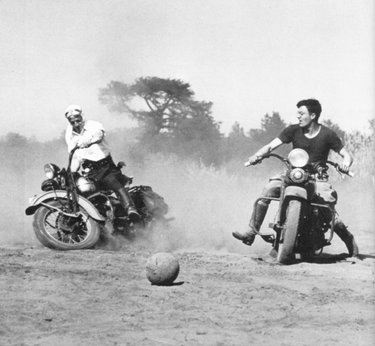Motorcycling’s deep history revealed in new picture book
We see people driving motorcycles every day on the road, and don’t usually think twice, but what can be said about the daredevils who race on frozen lakes or try to climb steep hills?
Simply put, they could be crazy.
“It’s all about the adrenaline rush,” said Mark A. Supley, a former motorcycle racer and author of Capital Region Motorcycling. “They take risks, and if not, they’d be playing checkers.”
Capital Region Motorcycling is the latest release from Arcadia Publishing’s The Images of America series, which celebrates the history of places around the country using archival photos. Supley, 61, of Glenville, is the club historian for Electric City Riders, and has been collecting images since the 1970s.
“It was a ton [of work],” said Supley of this, his first book, which documents the history of motorcycling in the Capital Region from 1913 to 1985.
One photo shows two men, each riding a motorcycle, chasing after a ball on dirt. The two men are playing something called motorcycle polo, which was an actual sport that started in the 1920s and faded out by the 1950s. It’s like soccer, but with motorcycles.
“It’s a revelation, really,” Supley said. “There were fields with goal posts, and some teams even traveled. There was an Electric City team that went to this tournament and won over better riders. These guys charged at each other, right, but didn’t wear helmets.”
Supley said that there used to be motorcycle polo matches all around the region, like at Empire Speedway in Menands and what is now Stadium Golf Course in Schenectady. “It was big for a short period of time,” he said.
The final chapter of Capital Region Motorcycling covers ice racing, which is still popular these days. Warners Lake and Thompsons Lake, both in the Helderbergs, have races every year.
“Winter came around and we still wanted to ride, so we rode on ice,” Supley said of his experiences on Saratoga Lake and Ballston Lake. “We put screws through the tires at first, but then found out about sheet metal screws that would work better. Originally, it was 20 kids screwing around, but became 150 riders racing on the weekends.”
Supley, who has sustained such injuries as a broken back, dislocated shoulder, and a cracked vertebra in his neck, hasn’t raced in many years, saying, “I have no body parts to give away.”
As a child, Supley had little money, so he built mini-bikes with lawnmower engines and bike frames. With whatever money he earned as a paperboy in 1967, Supley bought a 1965 125cc Kawasaki with a bad transmission.
“The dealer wanted $150 to fix it, and that wasn’t going to happen, so I took it apart and found a sheared key and replaced it,” said Supley. “It was the mother of necessity.”
Motorcycling has been Supley’s passion ever since, and his restored 1926 Harley Davidson sits on display at the Motorcyclepedia Museum in Newburgh. With all the searching and interviewing he has done over the years, he hopes Capital Region Motorcycling spikes interest in what seems to be a fascinating era.
“I wanted this to generate conversation amongst riders that are still alive,” Supley said. “It’s nice to reminisce.”

